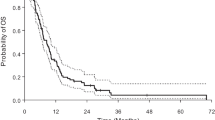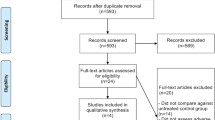Abstract
Bevacizumab (BVZ), a monoclonal antibody directed against vascular endothelial growth factor (VEGF), has been suspected to increase the incidence of ischemic stroke (IS) and intracranial hemorrhage (ICH) in GBM patients. Intracranial vascular events, such as IS and ICH, were retrospectively analyzed in 364 MRI scans of 82 patients with recurrent GBM (1st/2nd/3rd relapse). Out of these 82 patients, 40 were treated with BVZ (178 scans) in addition to basic treatment, whereas 42 patients matching for age and gender received basic treatment (186 scans). Distribution of typical vascular risk factors between both groups was analyzed retrospectively. In seven out of 82 patients (8%) vascular events were detected in MRI. Four vascular events were recorded in the BVZ-group (3 IS and 1 ICH), and 3 vascular events were found in the Control-group (1 IS and 2 ICH; p > 0.05 between both groups). Likewise, vascular risk factors (arterial hypertension, diabetes mellitus, obesity, former vascular event, hyperlipidemia, tobacco consumption and/or hypercholesterolemia) did not differ significantly between both groups. BVZ treatment does not seem to be associated with an increased risk for vascular events in patients with GBM in recurrence.




Similar content being viewed by others
References
Wen PY, Kesari S (2008) Malignant gliomas in adults. N Engl J Med 359(5):492–507
Weller M, van den Bent M, Hopkins K, Tonn JC, Stupp R, Falini A et al (2014) EANO guideline for the diagnosis and treatment of anaplastic gliomas and glioblastoma. Lancet Oncol 15(9):e395–e403
Stupp R, Mason WP, van den Bent MJ, Weller M, Fisher B, Taphoorn MJ et al (2005) Radiotherapy plus concomitant and adjuvant temozolomide for glioblastoma. N Engl J Med 352(10):987–996
Ostrom QT, Gittleman H, Fulop J, Liu M, Blanda R, Kromer C, et al (2015) CBTRUS statistical report: primary brain and central nervous system tumors diagnosed in the United States in 2008–2012. Neuro-oncology 17(Suppl 4):iv1–iv62
Stupp R, Hegi ME, Gilbert MR, Chakravarti A (2007) Chemoradiotherapy in malignant glioma: standard of care and future directions. J Clin Oncol 25(26):4127–4136
Duda DG, Jain RK, Willett CG (2007) Antiangiogenics: the potential role of integrating this novel treatment modality with chemoradiation for solid cancers. J Clin Oncol 25(26):4033–4042
Furnari FB, Fenton T, Bachoo RM, Mukasa A, Stommel JM, Stegh A et al (2007) Malignant astrocytic glioma: genetics, biology, and paths to treatment. Genes Dev 21(21):2683–2710
Jain RK, di Tomaso E, Duda DG, Loeffler JS, Sorensen AG, Batchelor TT (2007) Angiogenesis in brain tumours. Nat Rev Neurosci 8(8):610–622
Norden AD, Drappatz J, Wen PY (2009) Antiangiogenic therapies for high-grade glioma. Nat Rev Neurol 5(11):610–620
Kreisl TN, Zhang W, Odia Y, Shih JH, Butman JA, Hammoud D et al (2011) A phase II trial of single-agent bevacizumab in patients with recurrent anaplastic glioma. Neuro-oncology 13(10):1143–1150
Friedman HS, Prados MD, Wen PY, Mikkelsen T, Schiff D, Abrey LE et al (2009) Bevacizumab alone and in combination with irinotecan in recurrent glioblastoma. J Clin Oncol 27(28):4733–4740
Taal W, Oosterkamp HM, Walenkamp AM, Dubbink HJ, Beerepoot LV, Hanse MC et al (2014) Single-agent bevacizumab or lomustine versus a combination of bevacizumab plus lomustine in patients with recurrent glioblastoma (BELOB trial): a randomised controlled phase 2 trial. Lancet Oncol 15(9):943–953
Heiland DH, Masalha W, Franco P, Machein MR, Weyerbrock A (2016) Progression-free and overall survival in patients with recurrent Glioblastoma multiforme treated with last-line bevacizumab versus bevacizumab/lomustine. J Neurooncol 126(3):567–575
Stupp R, Weller M (2014) Questions regarding the optimal use of bevacizumab in glioblastoma: a moving target. Neuro-oncology 16(6):765–767
Kreisl TN, Toothaker T, Karimi S, DeAngelis LM (2008) Ischemic stroke in patients with primary brain tumors. Neurology 70(24):2314–2320
Scappaticci FA, Skillings JR, Holden SN, Gerber HP, Miller K, Kabbinavar F et al (2007) Arterial thromboembolic events in patients with metastatic carcinoma treated with chemotherapy and bevacizumab. J Natl Cancer Inst 99(16):1232–1239
Zangari M, Fink LM, Elice F, Zhan F, Adcock DM, Tricot GJ (2009) Thrombotic events in patients with cancer receiving antiangiogenesis agents. J Clin Oncol 27(29):4865–4873
Kuenen BC (2003) Analysis of prothrombotic mechanisms and endothelial perturbation during treatment with angiogenesis inhibitors. Pathophysiol Haemost Thromb 33(Suppl 1):13–14
Kunkel P, Ulbricht U, Bohlen P, Brockmann MA, Fillbrandt R, Stavrou D et al (2001) Inhibition of glioma angiogenesis and growth in vivo by systemic treatment with a monoclonal antibody against vascular endothelial growth factor receptor-2. Cancer Res 61(18):6624–6628
Rieger J, Bahr O, Muller K, Franz K, Steinbach J, Hattingen E (2010) Bevacizumab-induced diffusion-restricted lesions in malignant glioma patients. J Neuro-oncology 99(1):49–56
Fraum TJ, Kreisl TN, Sul J, Fine HA, Iwamoto FM (2011) Ischemic stroke and intracranial hemorrhage in glioma patients on antiangiogenic therapy. J Neurooncol 105(2):281–289
de Kock I, Mirhosseini M, Lau F, Thai V, Downing M, Quan H et al (2013) Conversion of Karnofsky Performance Status (KPS) and Eastern Cooperative Oncology Group Performance Status (ECOG) to Palliative Performance Scale (PPS), and the interchangeability of PPS and KPS in prognostic tools. J Palliat Care 29(3):163–169
Wahlund LO, Barkhof F, Fazekas F, Bronge L, Augustin M, Sjogren M et al (2001) A new rating scale for age-related white matter changes applicable to MRI and CT. Stroke 32(6):1318–1322
Wen PY, Yung WK, Lamborn KR, Dahia PL, Wang Y, Peng B et al (2006) Phase I/II study of imatinib mesylate for recurrent malignant gliomas: North American Brain Tumor Consortium Study 99–08. Clin Cancer Res 12(16):4899–4907
Cemil B, Tun K, Polat O, Ozen O, Kaptanoglu E (2009) Glioblastoma multiforme mimicking arteriovenous malformation. Turk Neurosurg 19(4):433–436
Gilbert MR, Dignam JJ, Armstrong TS, Wefel JS, Blumenthal DT, Vogelbaum MA et al (2014) A randomized trial of bevacizumab for newly diagnosed glioblastoma. N Engl J Med 370(8):699–708
Chinot OL, Wick W, Mason W, Henriksson R, Saran F, Nishikawa R et al (2014) Bevacizumab plus radiotherapy-temozolomide for newly diagnosed glioblastoma. N Engl J Med 370(8):709–722
Carden CP, Larkin JM, Rosenthal MA (2008) What is the risk of intracranial bleeding during anti-VEGF therapy? Neuro-oncology 10(4):624–630
Hapani S, Sher A, Chu D, Wu S (2010) Increased risk of serious hemorrhage with bevacizumab in cancer patients: a meta-analysis. Int Soc Cell 79(1–2):27–38
Grisold W, Oberndorfer S, Struhal W (2009) Stroke and cancer: a review. Acta Neurol Scand 119(1):1–16
Whitaker RM (1998) Low molecular weight heparinoid, ORG 10172 (danaparoid), and outcome after acute ischemic stroke: a randomized controlled trial. The Publications Committee for the Trial of ORG 10172 in Acute Stroke Treatment (TOAST) Investigators. JAMA 279(16):1265–1272
Dorresteijn LD, Kappelle AC, Boogerd W, Klokman WJ, Balm AJ, Keus RB et al (2002) Increased risk of ischemic stroke after radiotherapy on the neck in patients younger than 60 years. J Clin Oncol 20(1):282–288
Wakai S, Yamakawa K, Manaka S, Takakura K (1982) Spontaneous intracranial hemorrhage caused by brain tumor: its incidence and clinical significance. Neurosurgery 10(4):437–444
Zimmerman RA, Bilaniuk LT (1980) Computed tomography of acute intratumoral hemorrhage. Radiology 135(2):355–359
Jain RK (2005) Normalization of tumor vasculature: an emerging concept in antiangiogenic therapy. Science 307(5706):58–62
Eom KS, Kim DW, Kang S (2015) Emergency microsurgical embolectomy in acute ischemic stroke with diffusion-negative MRI. Neurol Neurochir Pol 49(6):432–435
Bernick C, Kuller L, Dulberg C, Longstreth WT Jr, Manolio T, Beauchamp N et al (2001) Silent MRI infarcts and the risk of future stroke: the cardiovascular health study. Neurology 57(7):1222–1229
Lim JS, Kwon HM (2010) Risk of “silent stroke” in patients older than 60 years: risk assessment and clinical perspectives. Clin Interv Aging 5:239–251
Vermeer SE, Longstreth WT Jr, Koudstaal PJ (2007) Silent brain infarcts: a systematic review. Lancet Neurol 6(7):611–619
Sandmann T, Bourgon R, Garcia J, Li C, Cloughesy T, Chinot OL et al (2015) Patients with proneural glioblastoma may derive overall survival benefit from the addition of bevacizumab to first-line radiotherapy and temozolomide: retrospective analysis of the AVAglio trial. J Clin Oncol 33(25):2735–2744
Chinot OL, Nishikawa R, Mason W, Henriksson R, Saran F, Cloughesy T et al (2016) Upfront bevacizumab may extend survival for glioblastoma patients who do not receive second-line therapy: an exploratory analysis of AVAglio. Neuro-oncology 18(9):1313–1318
Schaub C, Schafer N, Mack F, Stuplich M, Kebir S, Niessen M et al (2016) The earlier the better? Bevacizumab in the treatment of recurrent MGMT-non-methylated glioblastoma. J Cancer Res Clin Oncol 142(8):1825–1829
Hata N, Yoshimoto K, Hatae R, Kuga D, Akagi Y, Sangatsuda Y et al (2017) Add-on bevacizumab can prevent early clinical deterioration and prolong survival in newly diagnosed partially resected glioblastoma patients with a poor performance status. OncoTargets Ther 10:429–437
Saran F, Chinot OL, Henriksson R, Mason W, Wick W, Cloughesy T et al (2016) Bevacizumab, temozolomide, and radiotherapy for newly diagnosed glioblastoma: comprehensive safety results during and after first-line therapy. Neuro-oncology 18(7):991–1001
Sinnadurai M, McDonald KL (2017) Immune checkpoint inhibition and its relationship with hypermutation phenoytype as a potential treatment for Glioblastoma. J Neuro-oncology 1–14
Author information
Authors and Affiliations
Corresponding author
Ethics declarations
Conflict of interest
The author(s) declare that they have no competing interests.
Rights and permissions
About this article
Cite this article
Auer, T.A., Renovanz, M., Marini, F. et al. Ischemic stroke and intracranial hemorrhage in patients with recurrent glioblastoma multiforme, treated with bevacizumab. J Neurooncol 133, 571–579 (2017). https://doi.org/10.1007/s11060-017-2467-z
Received:
Accepted:
Published:
Issue Date:
DOI: https://doi.org/10.1007/s11060-017-2467-z




